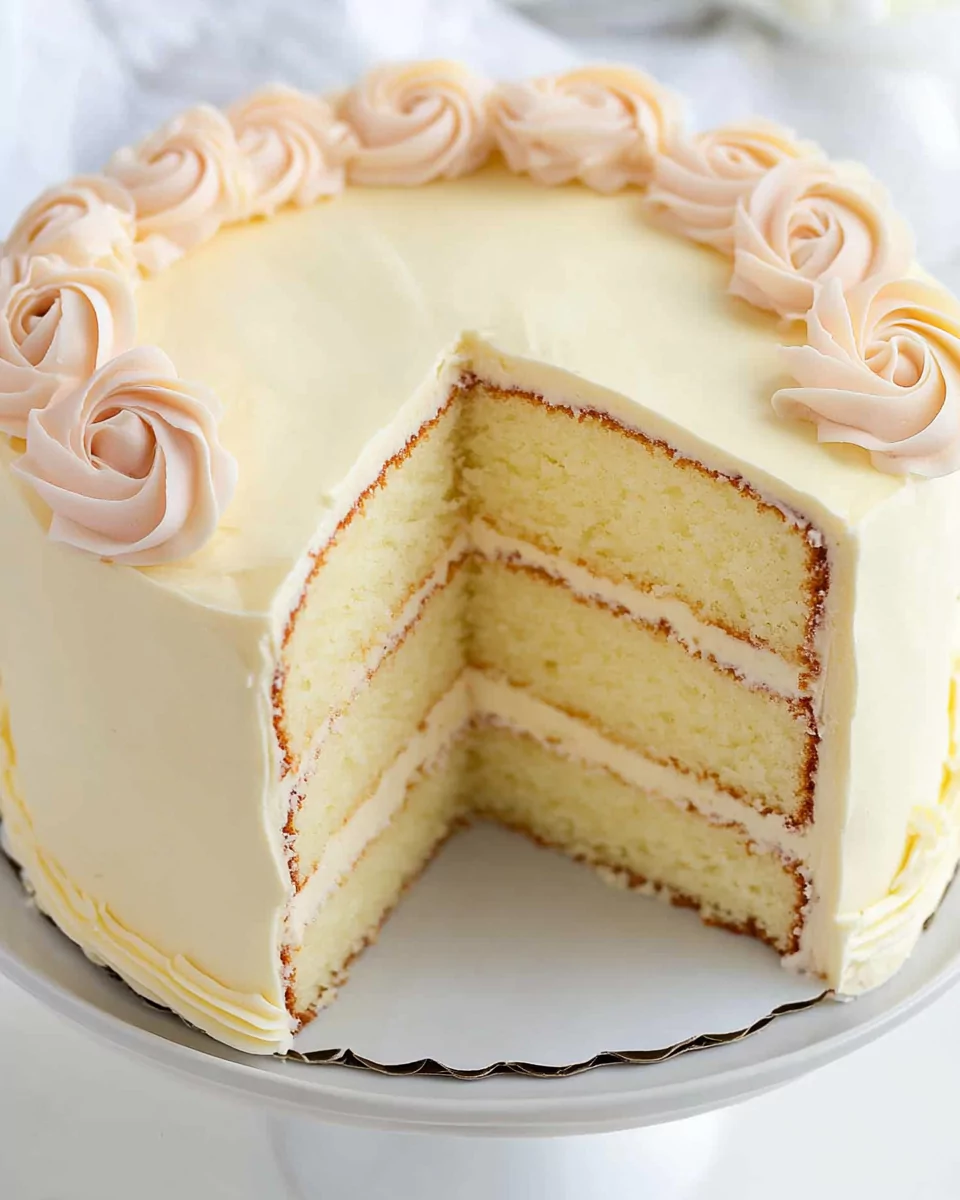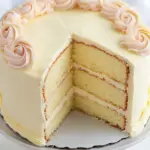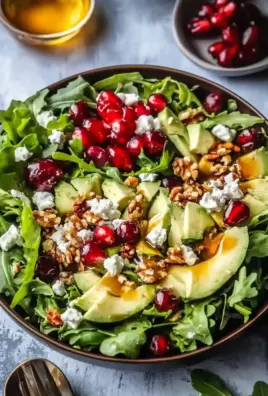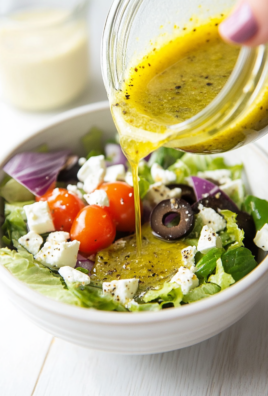Homemade Vanilla Cake: The Perfect Dessert for Every Occasion
This classic vanilla cake is the epitome of a timeless dessert. Its soft, tender crumb paired with a rich vanilla flavor makes it perfect for birthdays, anniversaries, or casual gatherings. Whether you top it with buttercream, drizzle it with chocolate, or enjoy it plain, this cake is simple, versatile, and irresistibly delicious.

Why You’ll Love This Recipe
- Beginner-Friendly: Requires only basic tools and straightforward steps.
- Versatile: Adaptable for cupcakes, layered cakes, or sheet cakes.
- Crowd-Pleaser: Loved by kids and adults alike.
Preparation Phase
Essential Tools and Equipment
- 9-inch round cake pans (2): Ensures even baking and perfect size for layering.
- Stand mixer with paddle attachment: Ideal for a smooth, lump-free batter.
- Measuring cups and spoons: Guarantees precise measurements for a consistent cake.
- Wire rack: Allows for even cooling of the cake layers.
- Parchment paper: Prevents sticking and makes cake removal hassle-free.
Why These Tools Are Important:
The right tools streamline the process, prevent mistakes, and result in a beautifully baked cake.
Preparation Tips
- Room-Temperature Ingredients: Ensure butter, eggs, and buttermilk are at room temperature for better mixing.
- Pre-Measured Ingredients: Pre-measure dry and wet ingredients to keep the process efficient and error-free.
- Accurate Oven Temperature: Use an oven thermometer to ensure your oven is calibrated correctly.
Ingredients for Homemade Vanilla Cake
Dry Ingredients:
- 3 ¾ cups (390 g) cake flour (or 3 cups (360 g) all-purpose flour)
- 2 cups (400 g) granulated sugar
- 1 tablespoon baking powder
- ½ teaspoon fine sea salt
Wet Ingredients:
- 1 cup (2 sticks) unsalted butter, at room temperature
- 1 ½ cups (340 g) buttermilk, at room temperature
- 1 tablespoon pure vanilla extract
- 3 large eggs, at room temperature
- 2 large egg whites, at room temperature
Step-by-Step Directions
1. Preheat the Oven
- Set your oven to 350°F (175°C).
- Line the bottoms of two 9-inch cake pans with parchment paper. Spray only the parchment with nonstick spray to ensure easy release.
2. Prepare the Dry Ingredients
- In a stand mixer fitted with a paddle attachment, combine the flour, sugar, baking powder, and salt.
- Mix briefly on low speed to combine the dry ingredients.
3. Add the Butter
- Add room-temperature butter to the dry mixture.
- Beat on medium speed for 1 minute until the mixture resembles coarse crumbs.
4. Incorporate Buttermilk and Vanilla
- Reduce the mixer speed to low.
- Slowly pour in the buttermilk and vanilla extract.
- Mix for 1 minute, then increase the speed to medium and beat for an additional 30 seconds. Scrape down the sides of the bowl to ensure all ingredients are evenly incorporated.
5. Add Eggs
- With the mixer on low, add the eggs one at a time, mixing well after each addition.
- Add the egg whites and beat on medium-high speed for 30 seconds until the batter is smooth and glossy.
6. Divide the Batter
- Evenly divide the batter between the two prepared cake pans.
- Smooth the tops with a spatula for even baking.
7. Bake the Cakes
- Place the pans in the preheated oven.
- Bake for 25–30 minutes, or until the edges are golden brown and a toothpick inserted into the center comes out clean.
8. Cool the Cakes
- Allow the cakes to cool in their pans for 5 minutes.
- Gently transfer them to a wire rack to cool completely before frosting.
Recipe Notes
- Make-Ahead Tip: Pre-measure and mix the dry ingredients in a jar for a quick homemade cake mix.
- Enhance Flavor: Use premium vanilla extract or vanilla bean paste for a richer taste.
- Prevent Dark Edges: If your oven runs hot, let the cake layers cool completely, wrap them in plastic, and let them rest for 24 hours before frosting.
Variations for Different Cake Sizes
- 9×13-inch Baking Dish: Bake for 45–50 minutes.
- 24 Cupcakes: Bake for 30–35 minutes.
- 3 8-inch Round Cake Pans: Bake for 25–30 minutes.
Frosting Tip
Freeze the cake layers for 30–60 minutes before frosting. This helps minimize crumbs and allows for smoother decoration. Pair with classic buttercream, chocolate frosting, or a whipped cream topping for the perfect finish.
Serving Suggestions
Elevate your homemade vanilla cake with these serving ideas:
- Classic Buttercream Frosting: A timeless pairing that complements the cake’s vanilla notes.
- Chocolate Ganache Drizzle: Adds richness and a touch of decadence.
- Fresh Berries and Whipped Cream: A light, refreshing combination ideal for spring and summer.
- Dusting of Powdered Sugar: Perfect for a simple and elegant presentation.
- Layered with Jam: Spread a layer of strawberry or raspberry jam between the cake layers for a fruity twist.
- Caramel Sauce and Pecans: Drizzle with caramel and top with chopped pecans for added texture and flavor.
Common Mistakes to Avoid & How to Perfect the Recipe
- Overmixing the Batter:
- Mistake: Mixing too long develops gluten, resulting in a dense cake.
- Solution: Mix ingredients just until combined. Stop as soon as the batter is smooth.
- Incorrect Measuring of Ingredients:
- Mistake: Scooping flour directly from the bag can lead to excess flour.
- Solution: Use the spoon-and-level method to measure dry ingredients accurately.
- Uneven Baking:
- Mistake: Cakes that bake unevenly or rise in the center.
- Solution: Rotate the pans halfway through baking and use cake strips to ensure even layers.
- Skipping Parchment Paper:
- Mistake: Cakes stick to the pan, making removal difficult.
- Solution: Always line the bottom of the pans with parchment paper and spray it lightly.
- Using Cold Ingredients:
- Mistake: Cold butter and eggs prevent proper mixing.
- Solution: Bring all ingredients to room temperature before starting.
Side Dish Recommendations
Pair your vanilla cake with these delightful sides to create a memorable dessert experience:
- Berry Compote
- A warm mixture of strawberries, raspberries, and blueberries adds a burst of flavor.
- Vanilla Ice Cream
- Serve a scoop of creamy vanilla ice cream for a classic pairing.
- Chocolate-Covered Strawberries
- The combination of chocolate and vanilla is always a hit.
- Lemon Curd
- The tanginess of lemon curd beautifully contrasts with the sweetness of the cake.
- Whipped Cream and Fresh Fruit
- Light and airy, this duo complements the cake without overpowering it.
- Espresso or Coffee
- A strong cup of coffee enhances the vanilla flavor of the cake.
- Coconut Cream
- For a tropical twist, add a dollop of sweetened coconut cream.
- Caramelized Bananas
- A quick and easy side that brings a sweet, caramelized flavor to the table.
Pro Tip:
For special occasions, transform the cake into a layered masterpiece. Add decorative frosting swirls, edible flowers, or sprinkles for a festive touch. This makes it perfect for celebrations like birthdays or weddings.
Recipe Tips
- Enhance the Vanilla Flavor:
- Use high-quality pure vanilla extract or vanilla bean paste for a rich and aromatic flavor.
- Freezing for Easier Frosting:
- Freeze the cake layers for 30–60 minutes before frosting. This minimizes crumbs and allows for smoother decoration.
- Achieving a Light, Fluffy Texture:
- Avoid overmixing the batter, which can make the cake dense.
- Experiment with Fillings:
- Add a thin layer of lemon curd, raspberry jam, or chocolate mousse between the layers for a delightful surprise.
Storage and Reheating Instructions
Storage Tips:
- At Room Temperature:
- Store unfrosted cake layers in an airtight container or wrap tightly in plastic wrap for up to 2 days.
- In the Refrigerator:
- Frosted cakes can be stored in the fridge for up to 5 days. Cover them to prevent drying out.
- Freezing:
- Wrap cooled, unfrosted cake layers in plastic wrap and aluminum foil. Store in the freezer for up to 3 months. Thaw overnight in the refrigerator.
Reheating Instructions:
- Allow the cake to reach room temperature before serving if stored in the fridge.
- For individual slices, microwave for 10–15 seconds to restore softness and warmth.
Frequently Asked Questions (FAQs)
1. Can I make this cake ahead of time?
Yes! Bake the layers in advance, wrap them tightly, and store them at room temperature or freeze until ready to use.
2. What can I use instead of buttermilk?
You can substitute buttermilk with a DIY version: Mix 1 ½ cups of milk with 1 ½ tablespoons of white vinegar or lemon juice. Let it sit for 5 minutes before using.
3. Can I use this recipe for cupcakes?
Absolutely! This recipe yields about 24 cupcakes. Bake at 350°F for 30–35 minutes, or until a toothpick inserted in the center comes out clean.
4. How do I prevent my cake from sticking to the pan?
Always line the bottom of your pans with parchment paper and spray the paper with nonstick spray. Avoid spraying the sides of the pan.
5. What’s the best frosting for this vanilla cake?
Classic buttercream frosting is the most popular choice, but you can also use cream cheese frosting, chocolate ganache, or whipped cream for variety.
6. Can I make this cake gluten-free?
Yes, replace the cake flour with a gluten-free flour blend designed for baking.
7. How do I know when the cake is done?
Insert a toothpick into the center of the cake. If it comes out clean or with a few crumbs, it’s ready.
8. Why is my cake too dense?
This could be due to overmixing, using cold ingredients, or incorrectly measuring flour. Make sure to follow the instructions carefully.
Conclusion
This homemade vanilla cake recipe is your ultimate go-to for a moist, tender, and flavorful dessert. Whether it’s a casual family dinner or a grand celebration, this cake shines with its versatility and crowd-pleasing appeal. Pair it with your favorite frosting, fillings, and sides to create a dessert experience that everyone will love.
With its simple preparation and delicious results, this cake is a must-try for bakers of all levels. Bake it today and enjoy a slice of perfection!
Homemade Vanilla Cake
Ingredients
- 3 ¾ cups 390 grams cake flour (or 3 cups (360 grams) all-purpose flour)
- 2 cups 400 grams granulated sugar
- 1 tablespoon baking powder
- ½ teaspoon fine sea salt
- 1 cup 2 sticks unsalted butter, at room temperature
- 1 ½ cups 340 grams buttermilk, at room temperature
- 1 tablespoon pure vanilla extract
- 3 large eggs at room temperature
- 2 large egg whites at room temperature
Instructions
- Preheat the Oven: Preheat the oven to 350°F. Line the bottoms of two 9-inch cake pans with parchment paper and spray only the parchment with nonstick cooking spray. Avoid spraying the sides of the pans.
- Mix the Dry Ingredients: In a stand mixer fitted with a paddle attachment, combine the flour, sugar, baking powder, and salt. Mix briefly to combine.
- Add Butter: Add the room-temperature butter and beat on medium speed for 1 minute, until the mixture resembles coarse crumbs.
- Add Buttermilk and Vanilla: Reduce the mixer speed to low and add the buttermilk and vanilla extract. Mix for 1 minute to combine, then increase the speed to medium and beat for 30 seconds. Scrape down the sides of the bowl.
- Add Eggs: Reduce the speed to low and add the eggs, one at a time, mixing well after each addition. Add the egg whites and beat on medium-high speed for 30 seconds, until the batter is smooth.
- Divide Batter: Divide the batter evenly between the prepared cake pans and smooth the tops with a spatula.
- Bake: Bake for 25–30 minutes, or until the edges are golden brown and a toothpick inserted into the center comes out clean.
- Cool the Cakes: Let the cakes cool in the pans for 5 minutes, then transfer them to a wire rack to cool completely before frosting.
Notes
Vanilla Flavor: Use high-quality vanilla extract or vanilla bean paste for the best flavor.
Prevent Dark Edges: If your oven runs hot, wrap the cooled layers in plastic wrap and let them sit for 24 hours before frosting.




Leave a Comment